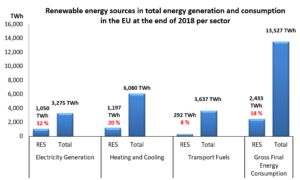“Energy taxes and emission trading systems complement each other”
October 1, 2021
Internalizing the costs of pollution into energy prices – this has been one of the key objectives of Climate Action Network (CAN) Europe for many years. In this context, two documents from the new Fit for 55 package are of major importance: the revision of the Energy Taxation Directive (ETD) and the initiative to extend the Emission Trading System (ETS) for road transport and building. Solarthermalworld.org spoke with Klaus Röhrig about the current drafts of the two documents and their relevance for the energy transition. He has been the EU Climate and Energy Policy Coordinator at the CAN Europe for almost five years.
Photo: CAN Europe
The current EU commission has speeded up the energy transition process. How has CAN Europe adapted its lobbying work to this new drive?
Röhrig: We have expanded our advocacy and communication capacity in the past years, and have pushed for ambitious revision of the EU’s overall climate target. CAN Europe now has a team of 28 experts in the Brussels office and 19 colleagues working remotely from outside of Brussels. We ensure that our policy teams have sufficient capacity to follow key climate and energy files of the European Green Deal agenda. In addition, we have increased our activities through our membership, which consists of 179 NGOs in 38 countries across Europe.
How high is the chance that networks like CAN Europe have an influence on figures, targets or requirements within the Fit for 55 legislation package?
Röhrig: Hard to estimate. The influence varies a lot across institutions and member states. Generally, we worry about shrinking civil society space in some Central and Eastern European member states.
Within the Fit for 55 package the EU’s Energy Taxation Directive (ETD) from the year 2003 is to be revised. How important is this, do you think?
Röhrig: The ETD revision is necessary and overdue. The scope and rates of the 2003 Directive do not cover and benefit all current energy carriers, such as renewable hydrogen. The taxation scheme does not discriminate between fossil fuels and renewables, and high carbon emitters benefit from generous exemptions.
A Europe-wide energy tax on fossil fuels could create a level-playing field so that renewable heat technologies can increase their deployment without subsidies. Do you see a realistic chance of finding consensus in all member states?
Röhrig: It very much depends on how progressive member states can weigh in as they need to agree on a final decision on this. The ETD revision is subject to unanimous voting at the Council, because it impacts the tax landscape on a national level. This makes approval much harder. Other directives like the Renewable Energy Directive or the Emissions Trading System Directive can be approved by the Council with a qualified majority. We saw this in 2013, when the approval of the ETD revision failed in the Council because not all member states agreed to the energy taxation suggested back then. However, this time there is a good chance of agreeing on a fairer, just and green taxation scheme because of the urgent need to increase electrification and phase out fossil fuels.
Within the Fit for 55 package an extended ETS for road transport and building was suggested. Do you agree with this approach?
Röhrig: While we support the strengthening of carbon pricing and the application of the polluter pays principle, we are still very sceptical about the proposal by the Commission to introduce the new ETS in such a rush. The first ETS reporting is already planned for 2024. A unified price, however, will have a very different impact in many member states and we must make sure that social impacts are avoided for poorer families across Europe and that affordable low-carbon alternatives are available in time. We doubt whether the member states will be ready for that in 2024, as the Social Climate Fund will only be started in 2023, so a year earlier.
Energy taxes and carbon taxes have the same regulatory effect. Does it make sense to implement both and how will energy taxes and ETS work together?
Röhrig: Both instruments can very well complement each other. Energy or carbon taxes can set a minimum price floor for energy that creates a more level playing field for renewable technologies, for example. In contrast to constant energy taxes, an ETS is generally more dynamic. The prices of emission certificates are usually lower at the beginning, but will increase over time because the quantity of emission rights will be continuously reduced. It seems that the Commission is going for both instruments at the moment. If they fail to approve a Europe-wide energy tax by anonymous voting in the Council, then they will fall back on the ETS which is in theory easier to approve. Yet, many member states are still not convinced about the new ETS proposal.
Do you know examples at member state level where energy taxes and/or ETS have been implemented successfully?
Röhrig: We have seen how Portugal implemented a carbon tax already in 2014 and revised it in 2018. The tariffs were progressively increased; this was very positive. It will be crucial that national tax schemes are not weakened or simply replaced by EU-wide instruments. Another positive example was the UK, when it was still a member of the EU. When the ETS prices was very low after the financial crises 2008/2009 at around 4 EUR/ton of CO2, the UK reacted and set up a carbon floor price of 18 GBP per ton of CO2 to complement the ETS for large energy consumers. The tax accelerated the national phase-out of coal and generated additional revenue that could be invested in increased renewable deployment and low-carbon technology.
What will be the next steps in approving the Emission Trading Directive and the extended ETS?
Röhrig: Currently the Council and the Parliament are looking at the proposals of the Fit for 55 package. Parliament members have announced that voting should take place in the first half of 2022, but we are not sure whether they will vote on the whole package or first pick some documents which they prioritize. A lot also depends on how long it takes to form the new government in Germany after the federal elections last week.
The upcoming French presidency is expected to speed up the negotiations. France announced that it is aiming for an agreement on the Carbon Border Adjustment Mechanism (CBAM) during the French EU presidency between January and June 2022. The CBAM will reduce carbon leakages which arise from importing carbon-intensive goods from outside the EU. This mechanism is closely linked to the ETS, so we expect that we will see a prioritization of the ETS Directive.

The Fit For 55 package includes a large number of directives and initiatives that need to be revised or started
Graphic: EU Commission
Organisations mentioned in this news article:


